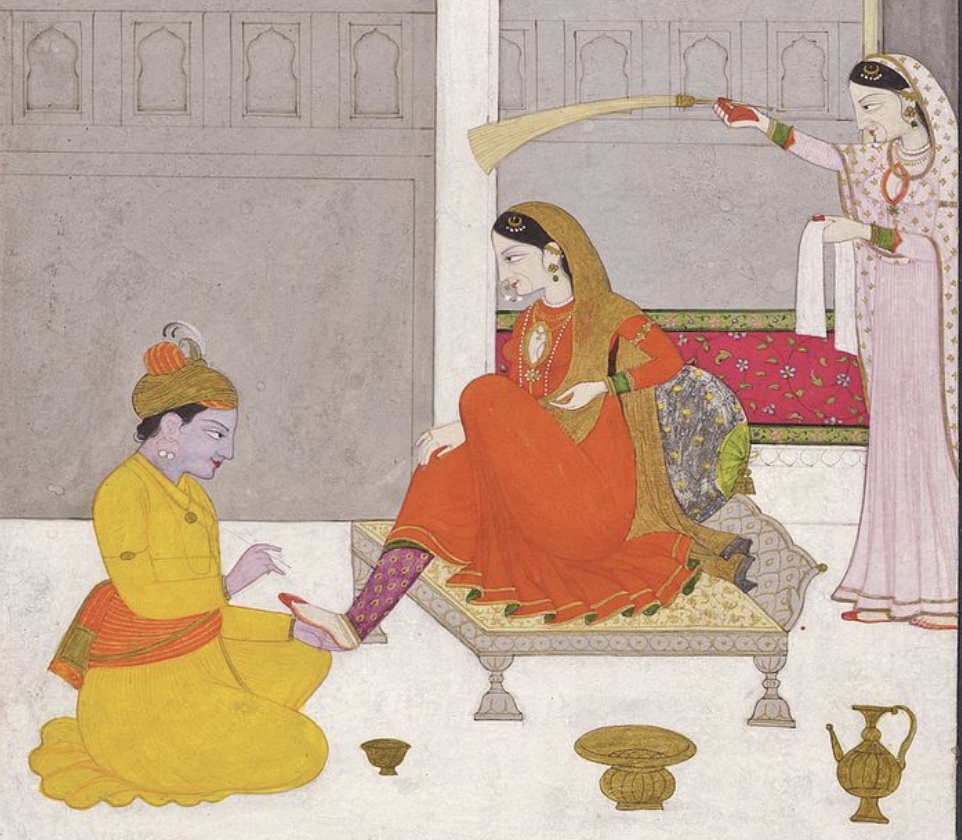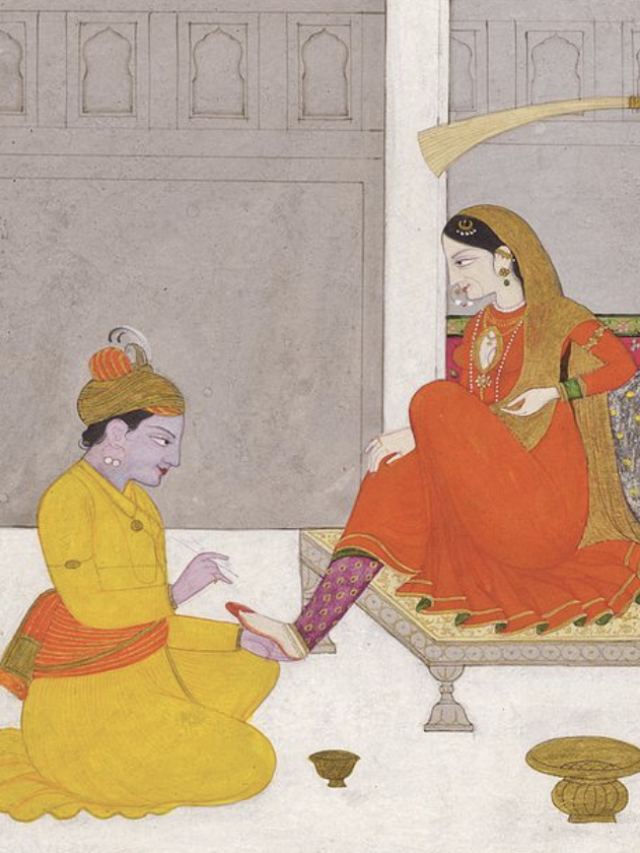Have you ever carefully observed how the facial features shift during a performance of an Indian classical dancer while performing? Or a heroine emoting during a theatrical performance or even within a movie? These are bhavas or expressions which are mentioned in our ancient texts. In this article, we shall be learning about Ashta Nayika, a term that refers to the eight different varieties of heroines, or nayikas, each with their position about their male lover, or nayaka. These eight heroines were briefly referenced in the Bharata Muni’s Natyashastra and expanded upon by aestheticians, poets, and visual artists during the medieval period. These eight heroines go through a variety of emotions that collectively suggest the emotions of love. These eight Nayikas represent eight different types of states or Avasthas about her hero or Nayaka.
It has been written and pondered over by many since its inception, it has been utilised in dance performances, visual arts, and culture. Ananda K. Coomaraswamy, a pioneering and respected historian and philosopher of Indian art also defines the eight Nayikas as lover, beloved, gentle, lordly, possessive, energetic, pleasing, miscreant, evil, untruthful, refractory, braggart, shameless, and cruel.

Ashta Nayika and Shringara Rasa
The Natyashastra divides nayikas into two states derived from the shringara rasa, which is connected with the sensual and romantic interactions of heroes and heroines. The two states are sambhoga (unity) and vipralambha (separation). The abhisarika nayika, vasakajja nayika, and swadhinapatika nayika, The proshitapatika nayika, vipralabdha nayika, virahotkanthita nayika, kalahantarita nayika, and khandita nayika are all in the state of separation. Let us dive into each bhava and the types of nayikas represented in the ancient scripture.
1. Swadhinapatika Nayika is pictured standing/sitting next to her lover, who is depicted lovingly massaging, cleaning, caressing, or putting lac dye on her feet. This is evidence of her Lover’s full submission.

2. Vasakasajja Nayika stands beside her bed, waiting for her beloved, as the maids prepare the house and bed for her lover’s greeting.

3. Kalahantarita Nayika This Nayika is mostly seen departing in deepest dejection from her beloved, whereas her lover is generally seen departing in anger. In this one sees the displeased heroine rejecting the advances of her lover. This is a Ragamala painting in oil, a part of the manuscript folio, and the symbols of the painting are quite reflective of the nayika’s rejection and maybe also the dejection of the lover. She is looking the other way, while the lover pleads and the darkness behind them is suggestive of this banter.

4. Khandita Nayika can be classified as a Nayika, who is playfully offended by her lover. She can be observed, questioning her beloved, in anger after they meet. She can also be considered as “possessive and insecure” towards her lover. Like in this painting, the characters’ body language shows that Nayika is upset, hence she can be labeled as Khandita Nayika. The picture has a balanced symmetry. Leading lines have a dynamic role in drawing the viewer’s attention to the central figures. The slight daylight suggests it’s either at the time of dawn or early morning.

5. Prositapatika Nayika, sitting with her Sakhi, is trying to soothe her as the time of Kṛiśhna’s return has passed and he has still not returned.

6. Vipralabdha Nayika is identical to Utkanthita Nayika, except in her case, the time has gone and her beloved has yet to meet her. He abandoned her. She may be seen ripping down her jewelry and dumping it on the floor in despair. Vipralabdha Nayika is further divided as Purvanugraha, Mana, Pravasa, and Karunya. An example of the same is given in the painting below: This painting portrays the Nayika as a Vipralabdha Nayika through her abandoned state. Every element in the frame, from the darkness of the night, the two birds perched silently on the tree, to the Nayika throwing away her jewelry is suggestive of the lonesome attitude of the nayika. The symbols direct the viewer’s focus to the Nayika. The grey skies and empty frame emphasise the emptiness of her mind.

7. Abhisarika Nayika is a heroine characterised by her journey to meet her beloved, navigating numerous obstacles such as snakes and ghosts. Her primary objective is to reunite with her lover, despite the challenges she faces. Depending on the time of her journey, the Abhisarika Nayika is further classified into five types: Sukla Abhisarika Nayika (Full Moon), Krishna Abhisarika Nayika (Dark Night/No-Moon), Diva Abhisarika Nayika (Day), Sandhya Abhisarika Nayika (Twilight), and Nisha Abhisarika Nayika (Night).

8. Utkanthita or Virahotkanthita Nayika is a heroine who eagerly awaits her lover at their chosen rendezvous point. She is frequently represented standing or seated on a leaf bed beneath a tree, along a stream, or at the edge of a woodland, usually at night. The scene around her generally features nervous deer grazing and snuffling the winds, ready to flee at the least disturbance, adding to the solitude and loneliness of the situation. Utkanthita Nayika and Abhisarika Nayika are regarded as the most poetic and frequently represented heroines from the Ashta Nayika series in Indian art.

While these nayikas have been a part of many miniature paintings, they are also seen in Kalighat artworks and other manuscripts. The expressions are also a major part of many classical dance forms. It also immensely influenced poets such as In Vijay Kumar Singh’s 2022 Hindi poetry collection “Chitralekha,” there is a section comprising 8 poems dedicated to the Ashta-Nayika. Each of these poems features a different Ashta-Nayika as its protagonist, with each poem named after the specific Ashta-Nayika it portrays. One can also find it in Pahari embroidery, particularly seen in Chamba Rumal from Himachal Pradesh, where the Ashta-Nayika is a central theme. These embroideries often depict the Ashta-Nayika in eight panels on the Rumal. Similarly, in Indian classical music, particularly in the Hindustani tradition, the eternal love between Radha and Krishna finds expression through the consciousness of Radha, which acts as a dominant leitmotif in the lyrics. This representation of Radha reflects the Ashta-Nayika concept, portraying her various moods and emotions, especially evident in the semi-classical genre like Thumri, where Radha is depicted as one of the Ashta Nayikas consumed by passionate love for Krishna.

Studying the Ashta Nayikas provides a thorough understanding of universal emotions and their depiction in numerous artistic mediums, particularly paintings. Indian artwork produces a compelling atmosphere that emotionally resonates with audiences through the addition of movements, postures, symbols, and elements from nature and mythology together. This ancient tradition not only explores emotions but also creates spiritual and mythological connections, creating a lasting impression on viewers.
References:
2.https://www.onmanorama.com/entertainment/art-and-culture/dancing-with-the-idea-of-romance.html
3.https://eshe.in/2020/05/22/ashtanayika-oorvazi-irani/
4. https://mapacademy.io/article/ashta-nayika/






